2021 Triumph Tiger 850 Sport Review - First Ride
Pop Quiz: If a Tiger 850, how many are left?
What Tiger 850? When I went to St. Louis to learn all about the new Triumph 900 family way back in December 2019, there were five Tiger 900s – two 900 GTs, two Rallys, and a base model Tiger 900. Sometime between then and now, Triumph decided to distinguish the base model by calling it Tiger 850 Sport, but in fact, it has the same 888 cc Triple as the other four bikes, supposedly slightly detuned.
2021 Triumph Tiger 850 Sport
| Engine | 19.0/20 |
| Suspension/Handling | 13.0/15 |
| Transmission/Clutch | 8.5/10 |
| Brakes | 9.0/10 |
| Instruments/Controls | 4.0/5 |
| Ergonomics/Comfort | 9.0/10 |
| Appearance/Quality | 8.5/10 |
| Desirability | 8.0/10 |
| Value | 7.5/10 |
| Overall Score | 86.5/100 |
Like a couple other manufacturers lately who’ve seen the advantage of having a low-price leader (like BMW and its new F900R and XR), Triumph throws the Tiger 850 Sport out there with an MSRP of $11,995. Which is pretty cheap, really. Off the bat, it reminded me of another favorite bargain street-biased ADV bike, the Suzuki V-Strom 1050. But the base model V-Strom now lists at $13,399; the off-roadier Honda Africa Twin starts at $14,399. And BMW’s new F900XR undercuts them all, at $11,695. Go, exotic Europeans!
If you’re one of those people who always comments that you don’t need no stinkin’ badges or ABS or cruise control or electronic suspension, you’re all set. The Tiger 850 is a super-fun, highly capable runabout for all seasons, and you’ll love it. For people like me, who are on record saying they wouldn’t buy a new motorcycle without electronic cruise control, well, the Tiger 850 is a non-starter. If I’m bustin’ out $12k for a new motorcycle, I’m going to go ahead and spend $2,775 more for the Tiger 900 GT. Which comes with CC, adjustable suspension, a bigger, 7-inch TFT display, lean-sensitive ABS and TC, et cetera.
Then again, I might be ticked off enough at Triumph for not offering cruise control as one of the 65 accessories they’re peddling for the Tigers, to just shop elsewhere. If you want cruise, Triumph’s again emulating BMW in making CC available only as part of the package that makes up the Tiger 900 GT or GT Pro (or the wire-wheeled off-roadier Rally or Rally Pro – the Rally Pro being the full monty Tiger at $17,100).
Really, where you live and how you ride determines how much Triumph 850/900 you need. In southern California, where I rarely ride in the rain, and where I came up when ABS was a novelty and traction control was science fiction, I could easily get by with the Tiger 850 Sport’s non lean-sensitive ABS and TC. And since it’s non-adjustable Marzocchi suspension feels like it was calibrated with just about my 180 pounds of flesh and gear in mind, I could get by with it too. I should be able to buy the 850 Sport and add cruise control dammit!
Oh, sorry. Tangent. This is a great little motorcycle, and I do mean little. I mean, it’s full sized, but Triumph does give all the Tigers the most expensive thing – light weight. On the MO scales, our test unit registered 477 pounds, and that’s with 5.3 gallons – around 32 pounds – of gas. BMW also pimps its F900XR’s light weight; their claim of 482 pounds wet is believable. The Yamaha Tracer 900 GT is in that ballpark too, but it’s a bit more sport-toury than ADV-sporty. Your V-Strom 1050, whose biggest advantage traditionally was its lightness, has ballooned out to 544 pounds.
Light weight doesn’t matter quite as much since the Tiger 850 Sport is an ADV really meant more for pavement use, but you can definitely appreciate it on our favorite tight twisty roads, where the Tiger reveals once again the depth of talent in Triumph’s suspension-calibrating department. A lighter steel trellis frame, now with a bolt-on aluminum subframe, moves the engine 40mm forward and 20mm lower than before. Split radiators allow the front wheel to be tucked in more closely, and you can feel the difference as you whip the Tiger from side to side like Siegfried and Roy, in a way that feels more sport than ADV – even with a 19-inch front tire (Michelin Anakee on our test bike).
Going into it, it felt like the 850’s non-adjustable suspenders might be a bit soft for hard use because they’re relatively cushy in everyday riding, but in actual corner-storming mode, everything holds up fine. A few years ago, Brembo Stylema brake calipers were exclusive to Ducati Panigale V4s; now they’ve trickled down to the Tiger 850, where they provide all the power and feel you’d expect, complete with steel braided lines. Overkill, really.
The 850 gets no IMU, though, and therefore, no lean-sensitive ABS. Again, if you ride in slippery conditions much, it’s worth moving up to the IMU-equipped Tiger 900 GT or GT Pro. But for those of us riding mostly in a desert and not attempting to emulate M. Marquez at every corner entry, no worries. You can decelerate really hard on the 850 before the front ABS kicks in. And when, not if, Joe Text turns left across your bow, it will do its best to save your bacon.
The new 888 t-plane crankshaft Triple is a hoot, producing a juicy low-end and midrange before hitting its 82-horsepower peak at just 8400 rpm. Triumph claims 85 horses for the Tiger 850 and 93.9 for all the other Tigers. On the dyno (actually two different Dynojet 250s), our Tiger 900 Rally Pro tested last year made only 2 more hp than the 850 (500 rpm higher), and the 900 actually made less torque – 58.5 lb-ft for the 850 to 57.1 for the 900 Rally Pro. Two hp and a single lb-ft may be within the margin of error of two different dynos, but at least you seem to be getting your full ration of beans with the 850. And, the T-plane crank dishes them out with an even spicier soundtrack than before.
The new 888 cc engine uses the same 78mm bore as Triumph’s smaller Street Triple 765 but comes by its extra 123 cc via 8.52mm longer stroke. Triumph’s torque specs for the two Triples has the 765 at 57 lb-ft and the Tiger at 60 – but the Tiger’s peak comes at just 6500 rpm instead of the ST’s 9400, and it’s already making 50 lb-ft at just 2700 rpm.
KTM 790 Adventure R v. BMW F 850 GS Adventure v. Triumph Tiger 900 Rally Pro
The kids loved it as an off-road motor in the Tiger 900 Rally Pro, and that same low/midrange torquey characteristic makes it an excellent everyday street motor/canyon assault weapon, too. The 850, of course, gets no quickshifter (not seeing it listed in Accessories either). The six-speed gearbox is so slick you barely miss it, and you barely need the slip-assist clutch either once you’re in second gear.
The new BMW F900XR might be the Tiger 850’s most direct competitor. Its new 895 cc parallel Twin makes a bit more hp – 85.5 to 82 – but the Triple’s 58.5 lb-ft of torque beats the BMW’s 53.7, and at only 7100 rpm instead of the BMW’s 8200. The Triumph is quite a bit gruntier, and has a smoother, more linear powerband to boot. Oh, and look at that spec: The BMW holds 1.2 gallons less gas, which makes the Triumph more like 12 or 13 pounds lighter.
This Tiger motor’s got fuel efficiency and range going for it, too: In spite of riding it around on SoCal pandemic freeways at elevated speeds, abusing it in the canyons, and riding repeatedly past Brasscannon’s Canon – we averaged 45 mpg. Its 5.3-gallon tank means you’re ready to get off and stretch before the low-fuel light comes on.
The only bone we have to pick with this engine is that around 5-6000 rpm and 80 to 90 mph, there’s quite a bit of buzz transmitted through the grips and footpegs. Below 80 and above 100 it’s not so bad. Our test bike only had 2 miles when we picked it up. It may be smoothing out, or we may just be getting used to it? I think it’s “B.” If you’re sensitive about vibration, insist on a test ride. (Or, pony up for a cruise control model, so you don’t have to hold on to both grips all the time.) Then again, a Throttlemeister-style bar-end cruise control might work fine and damp out the vibes… (now made by Kuryakyn).
Aside from the vibes and the missing CC button, the Tiger’s a nice place to spend some time just like most ADV-style motorcycles. The seat’s low enough and narrow at the front to make it easy for my 30-inch legs to find the ground, and that’s in the high setting; it’ll go 0.8 inches lower. The windscreen seems more aero than most, most of the time, and manually adjusts up and down 2.5 inches (once it was all the way up, I left it there). The bodywork projects out to protect your inner legs from windblast. There were some inklings of too much heat reaching some riders’ knees, and C. Rogers complained her feet were warm on the passenger pegs – but as the OG woman who cried wolf, her complaints about heat no longer really register. And my knees didn’t feel any engine heat on a day at the beach in the 60s, inside Kevlar-lined jeans and one layer of capilene.
The seat’s comfy enough, our 150-pound passenger liked the spacious passenger accommodations and its great grab handles; there’s even a little rack as standard equipment with a hole in the middle where a 1-liter water bottle fits nicely, and good bungee net attachment points. A helmet lock would be nice: No gots.
It’s a perfectly nice little $12,000 motorcycle, and 20 years ago, there’d be nothing more to ask for. Maybe 10 years ago. But now that we’ve seen all of life’s electronic niceties, how are we supposed to get along without them? I couldn’t go back to a landline. You?
We can confirm that the building blocks, the basic architecture, is more than sound, and the new Triple also produces great sound. But if you’re planning on adventuring more than an hour or two at a time on this ADV bike, you’re going to want to move up to the Tiger 900 GT at least ($14,700) or the full-boat GT Pro ($16,600).
As a group, these new middleweight ADV bikes have taken up where what they used to call the UJM left off (Universal Japanese Motorcycle, even if most of them no longer come from Japan), and that’s a good thing. So comfortable, so sporty, so flexible, easy to ride, and adaptable to a huge range of uses from commuting to crawling over boulders in Death Valley.
The 850 Sport’s a great street bike and would also be fine for dirt-road duty. It’s so good in fact, that if you ride one, you’re going to love it. And when that happens, you’re going to have to blow the college fund on one with all the modern conveniences. Triumph sucks us in again.
2021 Triumph Tiger 850 Sport
+ Highs
- Great torquey Triple, delicious soundtrack and fuelling
- Light makes right
- Nice suspension tuning, again
– Sighs
- Do I need to say it? No cruise control option
- I’d probably buy a base-model Indian FTR for $500 less just because it’s got cruise
- You know I’m right, just admit it
In Gear
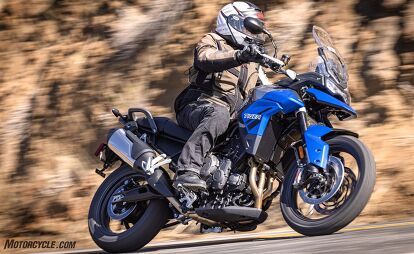
Helmet: Shoei Neotec 2 Splicer $799
- Jacket: Spidi Hard Track D124/A Discontinued
- Pants: Trilobite Parado Elastic Men’s Jeans $219
- Gloves: Dainese Quanto 4-Stroke Evo $220
Boots: Sidi Arcadia Tex $179
2021 Triumph Tiger 850 Sport Specifications | |
|---|---|
| Engine Type | Liquid-cooled, 12 valve, DOHC, inline 3-cylinder |
| Displacement | 888 cc |
| Bore x Stroke | 78.0 mm x 61.9 mm |
| Compression | 11.27:1 |
| Maximum Power | 82.8 hp at 8,400 rpm (MotoGPWerks dyno) |
| Maximum Torque | 58.5 lb-ft. at 7,100 rpm (MotoGPWerks dyno) |
| Fuel System | Multipoint sequential electronic fuel injection |
| Exhaust | Stainless steel 3 into 1 header system, side mounted stainless steel silencer |
| Final Drive | O-ring chain |
| Clutch | Wet, multi-plate, slip & assist |
| Gearbox | 6 speed |
| Frame | Tubular steel frame, bolt on sub frame |
| Swingarm | Twin-sided, cast aluminum |
| Front Wheel | Cast alloy, 19 x 2.5 in |
| Rear Wheel | Cast alloy, 17 x 4.25 in |
| Front Tire | 100/90-19 |
| Rear Tire | 150/70R17 |
| Front Suspension | Marzocchi 45mm upside down forks |
| Rear Suspension | Marzocchi rear suspension unit, manual preload adjustment |
| Front Brakes | Twin 320mm floating discs, Brembo Stylema 4 piston Monobloc calipers. Radial front master cylinder, ABS |
| Rear Brakes | Single 255mm disc. Brembo single piston sliding caliper, ABS |
| Instruments | 5″ TFT screen |
| Length | 88.50 inches (2248 mm) |
| Width (Handlebars) | 32.67 inches (830 mm) |
| Height Without Mirrors | 55.51-57.48 inches (1410-1460 mm) |
| Seat Height | 31.88-32.67 inches (810-830 mm) |
| Wheelbase | 61.25 inches (1556 mm) |
| Rake | 24.6° |
| Trail | 5.24 inches (133.3 mm) |
| Dry weight | 477 lbs (MO scales) |
| Fuel Tank Capacity | 5.28 gallons |
We are committed to finding, researching, and recommending the best products. We earn commissions from purchases you make using the retail links in our product reviews. Learn more about how this works.
Become a Motorcycle.com insider. Get the latest motorcycle news first by subscribing to our newsletter here.
More by John Burns



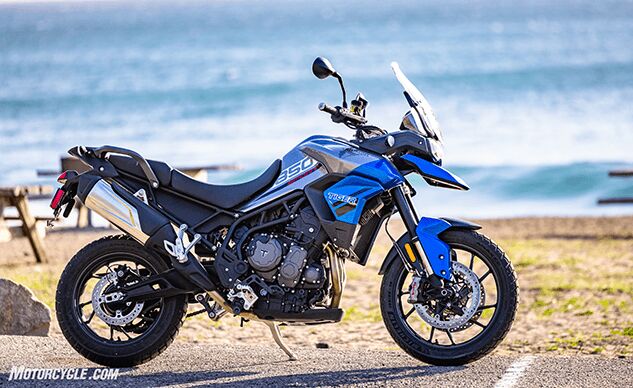



































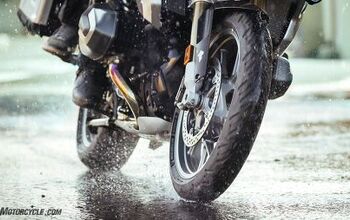
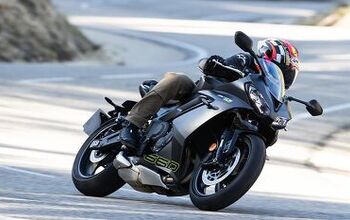
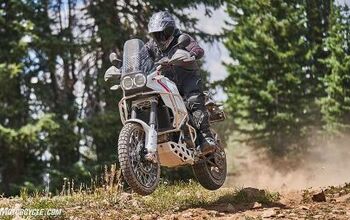
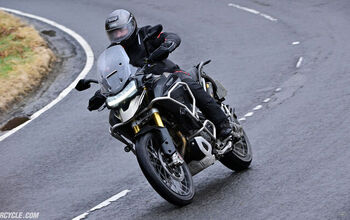
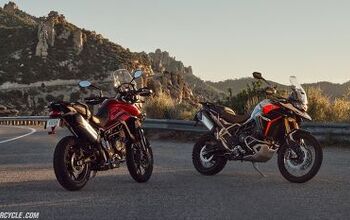
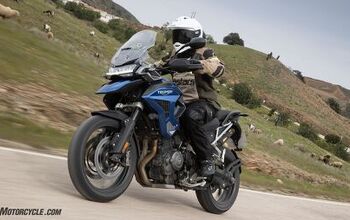
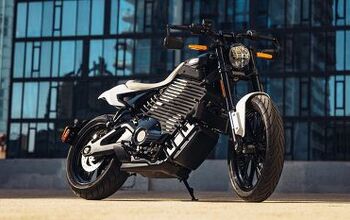
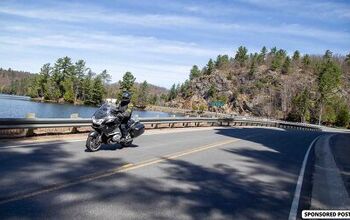
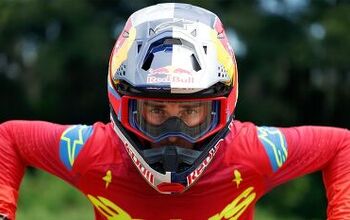
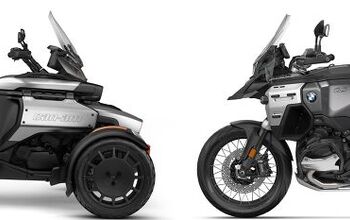
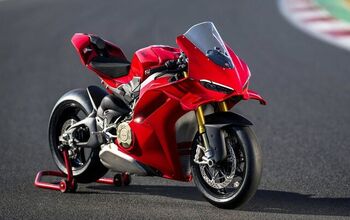



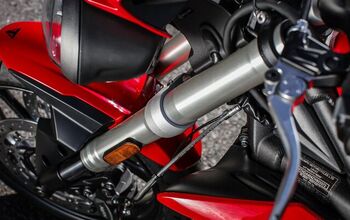
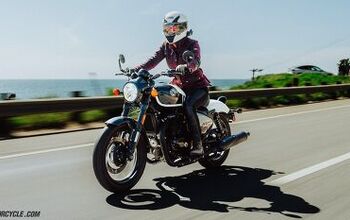


Comments
Join the conversation
Just caught JB's comment about the FTR, and agree wholeheartedly, except for the kinks in my knees. Love the FTR, I'm just too tall to fit. It can't possibly be that I'm really just too old to fold up my knees that way....
Just came back from riding the 850 from Victoria, B.C. to Ontario, clocked over 7000km and the bike performed flawlessly. Did I miss the cruise control riding through the prairies, maybe a little but honestly it was never a big deal. My bigger beef were the tires which unless you're perfectly straight make a weird, annoying noise. Somebody at Michelin dropped a ball on this one and i can't wait to put some street rubber on this bike. This thing is super fun as is and at no point did is wish i had additional riding modes, adjustable suspension or any other gadget, you just get on and go for a ride.